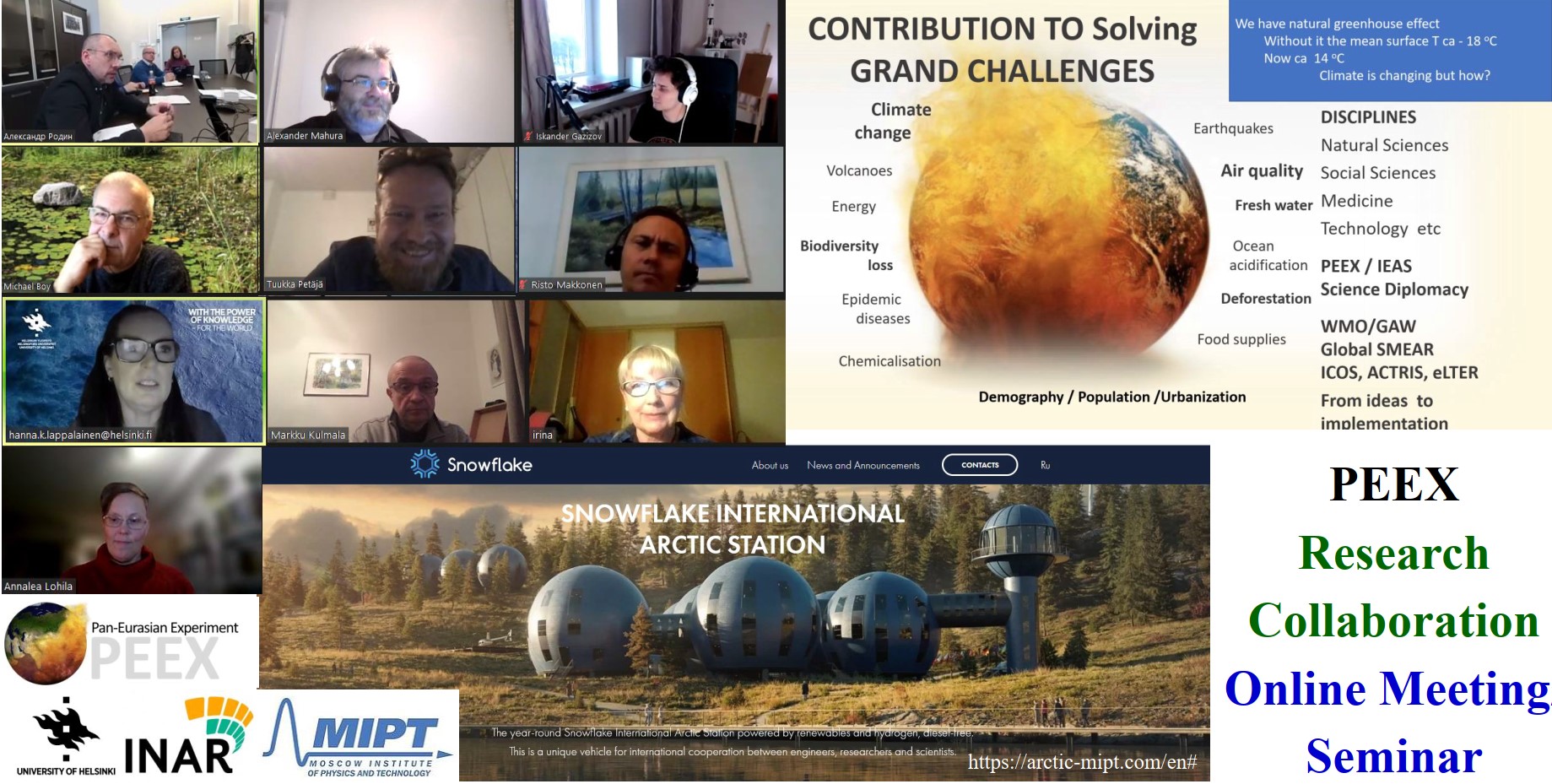Project Description
The PEEX research collaboration – University of Helsinki (UHEL), Institute for Atmospheric and Earth System Research (INAR) and the Moscow Institute of Physics and Technology (MIPT), Center for Environmental Monitoring (CEM) – online meeting/ seminar took place on 10 November 2021. The researchers (16) attended the meeting and delivered a series of presentations about INAR & GlobalSMEAR Initiative; research activities in the area of sustainable development at MIPT; PEEX programme science plan and research collaboration; ACTRIS & eLTER & SMEAR activities; high resolution laser heterodyne spectrometer for greenhouse gas monitoring network; INAR multi-scales and -processes modelling approaches; atmospheric sounding onboard UVA and microsatellites: implications to large-scale monitoring networks; ICOS Finland; science-oriented university education at MIPT and INAR.
Both the MIPT & UHEL colleagues learned about ongoing research carried out in the Universities. Discussions started around the GlobalSMEAR Initiative and the SMEAR concept, and in particular, to start practical cross-calibration of MIPT equipment/instruments at SMEAR-II station (https://www2.helsinki.fi/en/research-stations/hyytiala-forestry-field-station; Hyytiälä, Finland) and to make joint experiments at Hyytiälä. It is a good approach for common technological development with support of each other including joint observations in Russia and Finland and their intercomparison. It will also create an additional opportunity for visiting SMEAR-II (through ACTRIS Calls) with joint writing research plans with science focus and expected outcomes. All these will lead to joint publications in peer-reviewed journals. Moreover, it has been decided to initiate collaboration within frameworks of the Snowflake Arctic station (https://arctic-mipt.com/en; located in the Polar Ural region, Yamalo-Nenets Autonomous Okrug, Russia; important geographical area for long-term monitoring/ measurements in the Arctic), where the SMEAR station type approach/ measurements can be established as well as visits of Finnish researchers. Currently, the Snowflake project work is in development and a full operational capacity is expected in 2 years. Concerning modelling activities, MIPT is interested, first of all, in a local scale as well as collaborates with the Institute Numerical Mathematics, Russian Academy of Sciences on global climate modelling. The UHEL-INAR has multi-scales and -processes modelling capabilities (https://www2.helsinki.fi/en/researchgroups/multi-scale-modelling/research-and-models) and these modelling tools are integral part of the PEEX-Modelling-Platform (https://www.atm.helsinki.fi/peex/index.php/portfolio-items/modelling-platform).
Joint research activities and proposals/ projects are also beneficial, and these can include (to be continuously monitored) suitable Calls: ACTRIS for visiting and researching at the SMEAR-II station; NordForsk; Academy of Finland & Russian Science Foundation, when Calls on collaboration with Russia & Finland; joint Russian-Finnish Megagrants; Horizon-Europe Calls – involvement of MIPT as the PEEX Russian partner in the consortium with application for national funding from the Ministry of Science and Higher Education of Russia; Finland-Russia Cross-Border-Collaboration programmes; and other opportunities.
For PEEX as well as for the Universities, the science education is important, and similarly, joint educational activities and proposals/ projects are important aspect of mutual collaboration, and these include: students’/ teachers’/ researchers’ exchanges and academic mobility; joint co-supervision of students; bi-lateral Finland-Russia Calls from the Finnish Ministry of Education and Culture (TFK programme); Erasmus+ Calls – with educational focus, mobilities for individuals, etc.; Marie Skłodowska-Curie Actions – with creating network of Doctoral Training Centres (under PEEX umbrella); Erasmus+ strategic / cooperation partnerships Calls for actions called “Forward-looking projects” – with answering central challenges in education and training for climate change sciences; Erasmus Mundus Joint Masters – with developing high level integrated MSc programmes in physical, atmospheric, other sciences; Russian Science Foundation suitable Calls – for University education, young scientist schools, etc.
The nearest join plans are: signing the PEEX MoU; continuously monitoring suitable research and educational Calls and jointly applying; discussing/signing agreement on students/teachers mobilities/exchanges; arranging visits between MIPT and UHEL. The MIPT plans to prepare/ design a roadmap (research and education) for the nearest and long-term collaboration with PEEX; and to initiate discussions and arrangements on putting instruments for measurements at SMEAR-II station. The UHEL plans to arrange MIPT visit to the SMEAR-II station and start (Jan 2022) to involve MIPT into the TFK PEEX-FRESReN project activities on science education.
Text by Irina Obukhova, Alexander Rodin (MIPT) & Hanna K. Lappalainen, Alexander Mahura (UHEL-INAR)

